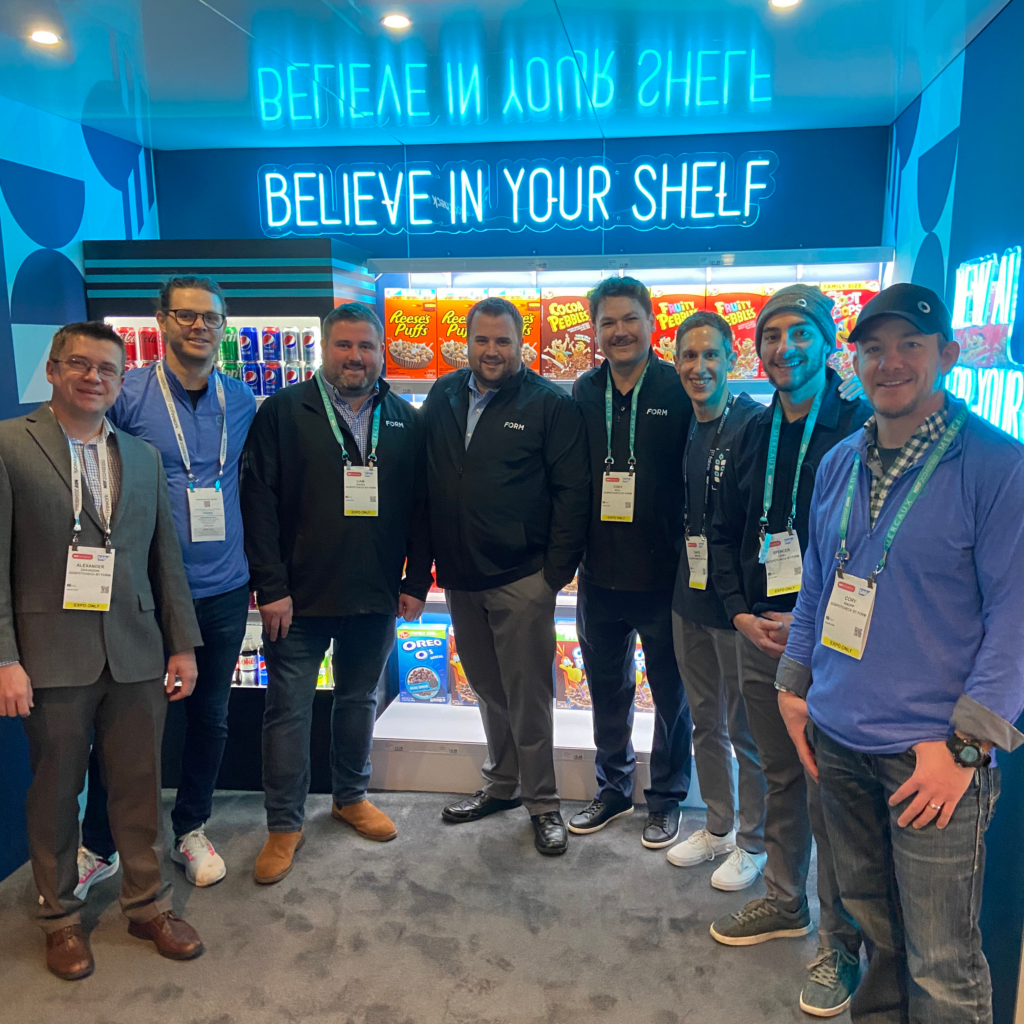What’s in Store for Retailers This Year
The National Retail Federation’s Retail’s Big Show commenced two weeks ago, but it’s still fresh in our minds. With 40,000 attendees, 6,200 brands, and more than 1,000 other exhibitors, there was a LOT to take away from this event.
Alexander Zagvazdin, Ph.D., Chief Product Officer at FORM, shared his insightful reflections on the cutting-edge technology unveiled to retailers during the show. According to Zag, “There’s a soaring demand for technology that empowers retailers to enhance their execution capabilities.”
Although fitting all our takeaways into a single blog post seems impossible (we barely managed to cover everything during the three-day event!), we’ve gathered some of our key insights from the event and offer a look at what’s in store for the retail industry this year. (See what we did there.)
Beyond the Hype: The Realities of Implementing AI
The resounding buzzword that dominated 2023 was undeniably AI. Every research and consulting firm, news pundit, and social media influencer seemed to be discussing AI: the good, the bad, and the ugly. At NRF, it was clear that AI was the center of attention for nearly every keynote, showcased technology, and conversation.
But why did AI take the spotlight in 2023? According to Anshu Bhardwaj, Senior Vice President and Chief Operating Officer of Walmart Global Technology and Walmart Commerce Technologies, it’s because there was a convergence of technological advancements and availability. What was once exclusive to large corporations for developing Jeopardy-playing robots or self-driving cars became accessible to millions of consumers. However, this accessibility also raised questions and concerns. Despite ChatGPT hitting 100 million users in less than a year, there remains some consumer uncertainty about interacting with AI and the implications of integrating the tool so heavily. Even though we may be tired of reading about it in the headlines, it’s critical to continue the discussions around AI and its applications. These ongoing conversations are crucial, not just for individuals but for retailers, software companies, and other organizations.
Applying AI in The Workplace
In today’s business landscape, adopting AI technologies has become more of a necessity than a competitive edge. In many instances, businesses simply can’t operate without some use of AI. This sentiment echoed throughout NRF, where speakers and companies both emphasized the indispensability of AI in modern workplaces. It’s now an integral part of both internal operations and customer-facing processes across organizations of all sizes and impacts.
Despite continuing apprehension, it does appear there is no longer anxiety that AI will replace human workers. Many speakers at the event underscored the irreplaceable role of human workers in organizations. All businesses are people-led, and nothing can replace the frontline. AI can simply empower them. However, it does seem that businesses don’t know exactly how to implement AI in a way that empowers and engages the workforce. Bhardwaj suggested that businesses should be implementing AI from a 360-degree approach, weaving it into the day-to-day for store associates, merchants, and even the remote workforce.
Ultimately, all businesses want to leverage AI in a way that enhances productivity boosts the bottom line. However, maintaining a customer-centric approach is vital. In a thought-provoking session with Salesforce Chair and CEO Marc Benioff and Walmart U.S. CEO John Furner, both mentioned the importance of maintaining consumer trust and adhering to your core values when it comes to implementing AI. Transparency and ongoing dialogue with customers are essential, especially in a rapidly evolving AI landscape. Keeping the conversation open and consumer-focused is key as businesses continue to navigate the complexities of AI integration.
Retail Media is Entering its Next Chapter
In another insightful session, Yael Cosset, Chief Information Officer and Senior Vice President at The Kroger Co., spoke with Sucharita Kodali, Vice President and Principal Analyst at Forrester Research on the future of retail, specifically grocery. Cosset drew parallels between the evolution of AI and retail media, stating that retail media is beyond its early stages, and is now becoming the standard. More and more retail brands are becoming familiar with its benefits and leveraging it to deliver relevant and personalized content to shoppers at every stage of the buying journey.
According to a recent report by media group Skai, 96% of surveyed individuals confirmed that their retail media programs achieved the desired brand impact last year, validating that it needs to be a key component of every retailer’s strategy. In fact, 87% of marketers reported that their organizations plan to maintain or increase spending on retail media in the coming year, while 93% believe it will remain a priority. This, in turn, means it is a priority for retailers to unlock the power of their retail media networks. At NRF, Cosset shared that one of Kroger’s biggest investments for 2024 is enhancing retail media capabilities as well as digitizing business processes and data and the consumer experience.
Cosset, expectedly, also touched upon the essential role of AI, agreeing with Bhardwaj’s perspective that it should be used for all key players in retail, including consumers, frontline associates, and back-office employees. He emphasized AI’s capacity to build sophisticated processes, optimize task allocation, and help prioritize activities so associates can focus on what directly impacts customers. With less time spent on tedious tasks, frontline employees can create more dynamic and engaging experiences for customers in each specific store, situation, and moment.
Offline, Online, Omnichannel
Another big buzzword at the show: omnichannel. Retailers no longer consider their online, mobile, and in-person stores to be separate, and they are heavily invested in bridging the gap between these experiences and creating one, cohesive experience for shoppers. Anshu Bhardwaj of Walmart takes it even one step further, saying that retailers should go beyond omnichannel to become adaptive retailers – providing retail spaces designed to accommodate a wide range of customer journeys, priorities, and desires. Walmart’s Executive Vice President and Global Chief Technology Officer and Chief Development Officer Suresh Kumar, agrees. “It’s retail that is not only e-commerce or in-store but a single, unified retail experience that seamlessly blends the best aspects of all channels,” he said at another recent retail-focused show.
When it comes to omnichannel strategies, it’s about more than just shopping; it’s how retailers can integrate the shopping experience into the everyday. During one NRF session, executives from H&M Americas and Spotify—two companies with vastly different products and services—discussed the importance of bridging together experiences, such as curated Spotify playlists playing in each H&M store. Another innovative example, shared by Bhardwaj, was Walmart’s “text-to-shop” experience, which integrates shopping with something as prevalent and second nature in everyone’s lives–texting.
The emergence of cutting-edge technologies like Augmented Reality and Virtual Reality will even further redefine omnichannel, effortlessly weaving the store experience into everyday life. Once retailers embrace these advancements, omnichannel will be the new morn, enriching customer interactions and driving engagement across channels.
Customer Focus Remains First
Regardless of emerging technologies, changing behaviors, and streamlined channels shaping the industry, NRF’s show made it clear that there is one timeless truth about retail. The number one priority for retailers is still (and always will be) customer experience. At the end of the day, it’s about understanding your consumers’ fundamental needs and desires and catering to them ceaselessly.
In her session on reinventing retail for the AI generation, Anshu Bhardwaj emphasized the importance of customer-centricity. “You start with the customer. You identify: What are the pain points? What could be delighters?” From here, teams can craft a strategy that not only builds growth and competitiveness but also resonates with consumers.
FORM CPO Zag agreed with this sentiment, noting that “retailers want to delight customers, whether it’s fully stocked shelves and carefully executed planograms or completely autonomous stores.”
At its core, retail is an extremely people-first industry. Despite the rapid advancements in technology and the increasing integration of AI, the spirit of creating memorable, personalized, and seamless experiences for shoppers remains unchanged. As retailers navigate the ever-evolving landscape, prioritizing customer-centricity will continue to be the cornerstone of success.
How GoSpotCheck is Solving Retailer Needs
GoSpotCheck by FORM was thrilled to participate in NRF’s show, alongside industry giants and cutting-edge solutions. Engaging in many valuable conversations, we showcased our latest innovation: automated planogram compliance for retailers.
“At the event,” Zag says, “GoSpotCheck was able to wow the attendees with our ready-to-go planogram compliance solution that is low-cost and easy to implement, yet still solves the most critical planogram compliance needs.”
If you couldn’t catch us at the event and want to explore the features Zag mentioned, be sure to check out our resources on how GoSpotCheck empowers retail teams!








